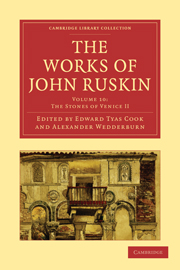Book contents
- Frontmatter
- Contents
- LIST OF ILLUSTRATIONS
- INDEX TO THE ILLUSTRATIONS
- INTRODUCTION TO THIS VOLUME
- BIBLIOGRAPHICAL NOTE
- The Stones of Venice, Vol. II. (CONTANING THE TEXT OF ALL THE EDITIONS)
- FIRST, OR BYZANTINE, PERIOD
- CHAP. I THE THRONE
- CHAP. II TORCELLO
- CHAP. III MURANO
- CHAP. IV ST. MARK'S
- CHAP. V BYZANTINE PALACES
- SECOND, OR GOTHIC, PERIOD
- AUTHORS APPENDIX
- Plate section
CHAP. V - BYZANTINE PALACES
Published online by Cambridge University Press: 05 November 2011
- Frontmatter
- Contents
- LIST OF ILLUSTRATIONS
- INDEX TO THE ILLUSTRATIONS
- INTRODUCTION TO THIS VOLUME
- BIBLIOGRAPHICAL NOTE
- The Stones of Venice, Vol. II. (CONTANING THE TEXT OF ALL THE EDITIONS)
- FIRST, OR BYZANTINE, PERIOD
- CHAP. I THE THRONE
- CHAP. II TORCELLO
- CHAP. III MURANO
- CHAP. IV ST. MARK'S
- CHAP. V BYZANTINE PALACES
- SECOND, OR GOTHIC, PERIOD
- AUTHORS APPENDIX
- Plate section
Summary
§ 1. The account of the architecture of St. Mark's given in the previous chapter has, I trust, acquainted the reader sufficiently with the spirit of the Byzantine style; but he has probably, as yet, no clear idea of its generic forms. Nor would it be safe to define these after an examination of St. Mark's alone, built as it was upon various models, and at various periods. But if we pass through the city, looking for buildings which resemble St. Mark's—first, in the most important feature of incrustation; secondly, in the character of the mouldings,—we shall find a considerable number, not indeed very attractive in their first address to the eye, but agreeing perfectly, both with each other, and with the earliest portions of St. Mark's, in every important detail; and to be regarded, therefore, with profound interest, as indeed the remains of an ancient city of Venice, altogether different in aspect from that which now exists. From these remains we may with safety deduce general conclusions touching the forms of Byzantine architecture, as practised in Eastern Italy, during the eleventh, twelfth, and thirteenth centuries.
§ 2. They agree in another respect, as well as in style. All are either ruins, or fragments disguised by restoration. Not one of them is uninjured or unaltered; and the impossibility of finding so much as an angle or a single story in perfect condition is a proof, hardly less convincing than the method of their architecture, that they were indeed raised during the earliest phases of the Venetian power.
- Type
- Chapter
- Information
- The Works of John Ruskin , pp. 143 - 179Publisher: Cambridge University PressPrint publication year: 2010First published in: 1904



